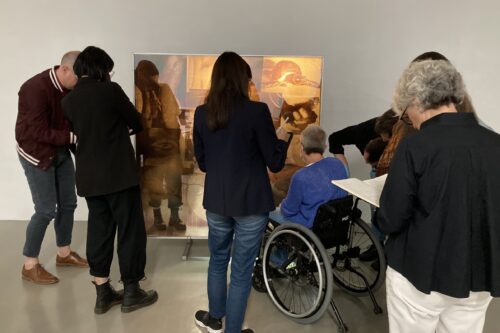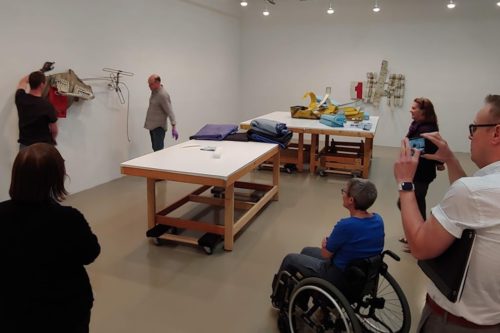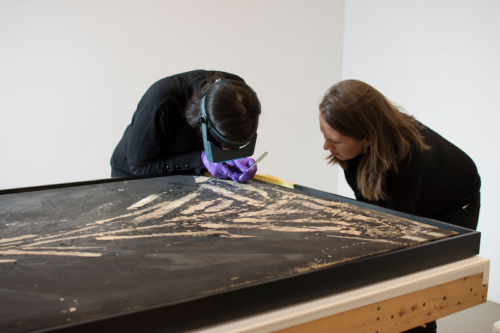Research

VoCA Research pairs senior conservators from the VoCA Network with conservation graduate students to conduct object surveys and technical examinations, all in support of the long-term preservation of artwork held in artist-endowed foundations. VoCA Research builds relationships across disciplines and generations by providing conservation graduate students hands-on training in contemporary art preservation while working collaboratively alongside colleagues from artist-endowed foundations.
We launched VoCA Research in partnership with the Robert Rauschenberg Foundation and Winterthur University of Delaware Program in Art Conservation. Following the success of that partnership, we are looking to expand VoCA Research to include other artist-endowed foundations. VoCA’s goal is to leverage our network to preserve the works of contemporary artists. To that end, if your artist-endowed foundation or artist estate is in need of conservation research and guidance and would like to partner with VoCA, please reach out to Executive Director Lauren Shadford at lauren@voca.network.
Background
Since VoCA’s inception in 2010, the leadership team has envisioned and worked towards a program stream that would support collections-based research in the stewardship of contemporary art. In 2018, VoCA Research was launched, combining collections research with expanding educational opportunities in the conservation of contemporary art.
Owing in part to the tireless work of the Aspen Institute’s Artist-Endowed Foundation Initiative, the number of foundations doing important work to shepherd artists’ legacies has increased dramatically. From years of convening colleagues across the field, VoCA has gained a keen understanding of the conservation needs of these artist-endowed foundations. VoCA Research seeks to address these needs, providing critical insight and conservation support where it is most needed. We are inspired to leverage the knowledge and the network that we have built over the last decade to continue to help the field preserve the important work of contemporary artists.
In 2018, Voices in Contemporary Art (VoCA), The Robert Rauschenberg Foundation (RRF) and the Winterthur/University of Delaware Program in Art Conservation (WUDPAC) launched a groundbreaking partnership that provides a new educational model for conservation in contemporary art, while addressing the specific object-based research needs of an artist-endowed foundation. This multi-year collaboration pairs second-year conservation graduate fellows with a team of leading conservators from VoCA, professors of conservation and conservation science from WUDPAC, and RRF staff to provide the students with first-hand, real-world experience concerning the material demands of contemporary art. Working together, the team demonstrates and realizes the highest levels of research, scholarship, and art stewardship for the Foundation’s artwork holdings.
As part of this partnership, students are offered the opportunity to aid the RRF with two major strategic ambitions: conducting a collections survey and launching a catalogue raisonné project. These goals are advanced through deep technical study of selected works and the development of a comprehensive collections manual to support the long-term care of Rauschenberg’s diverse and prolific output.
The project also brings together the unique attributes of each partner. The conservation students have an unparalleled opportunity to help maintain the Foundation’s collection, supporting object-level preservation priorities; RRF gains enhanced access to preservation resources for its collection needs while gleaning valuable information to support its catalogue raisonné initiatives; and VoCA has an opportunity to leverage its strengths as a global platform for professional learning and exchange. For many of our fellows, the growth in their professional communities and networks is an important outcome beyond their technical conservation goals. VoCA is proud to foster this type of interdisciplinary, intergenerational relationship building.

This multi-year collaboration provides students with first-hand, real-world experience concerning the material demands of contemporary art.
Year One (2018 – 2019)
In the inaugural year of the collaboration, the partnership team hosted two fellowships. Jennifer Myers, WUDPAC fellow, completed a material study of Rauschenberg’s paintings circa 1951-53, with particular focus on the Night Blooming (1951) series. She also studied the long-term stability of materials commonly used in their storage. Natalya Swanson, WUDPAC fellow, focused on the use of metal in Rauschenberg’s painting and sculpture. She carried out technical examinations of pieces in both the Borealis (1988–92) and Copperhead (1985/1989) series. Methods for documenting change in shiny, reflective metals surfaces were an additional focus of her research.
Year Two (2019 – 2020)
The second year of the fellowship focused on Rauschenberg’s textile works, and specifically his Hoarfrost (1974–76) series. Maddie Cooper, WUDPAC fellow, used the series to develop her expertise in design and execution of condition surveys, scientific analysis of storage materials, environmental analysis of display areas, and emergency response training for gallery spaces. The combination of the outcomes of this work will guide the long-term care of this series, and others, in private and public collections.
Year Three (2020 – 2021)
The third year of this partnership continued a focus on textile work, and added a new element by honing in on Rauschenberg’s works that include rubber. In the Summer of 2020, Kris Cnossen, WUDPAC fellow, worked remotely and created an extensive sheer fabric library – both physically and digitally. During the Fall 2020 and Spring 2021 semester, the partnership team focused on a 1973 work from the Venetian series as a case study to investigate the effectiveness of anoxic storage for tire rubber. Kris compared the large body of work that already exists with regard to the degradation and storage of rubber and focused on whether anoxic storage is an effective and practical preservation strategy. In the year after their fellowship, Kris continued to work with a team on a Rauschenberg-related case study entitled Environmental Impacts of Anoxia Treatments.
Year FOUR (2021 – 2022)
In the fourth year of our partnership, Elle Friedberg and Sarah Freshnock (our two WUDPAC fellows) focused their research on inkjet transfer artworks by Robert Rauschenberg made between 1992-2008. Elle embarked on an analytical investigation of Rauschenberg’s dye and pigment-based inkjet transfer works, in an effort to identify colorants and elucidate their fading patterns. She also designed an item level survey for these artworks, and used it as a tool to document a portion of the collection. Sarah researched the efficacy of cold storage to extend color fastness for these large inkjet transfer prints. Her analytical work centered on one specific conservation adhesive—poly vinyl acetate (PVA)—with the goal of ascertaining if PVA could be safely frozen and thawed without negative effect on the works of art. She complemented this work with an investigation of the environmental, social, and economic sustainability of cold storage for this large collection within the context of the Robert Rauschenberg Foundation holdings.
Year FIVE (2022 – 2023)
The fifth year of the partnership focused on time based media, specifically the Carnal Clocks (1969) series. WUDPAC fellow Daniella Briceño Villamil carried out a materials research study of the mirroring process Rauschenberg used in the series. This study involved archival research and an analysis of the clock face of Arrow (Carnal Clock) (1969), using portable analytical instrumentation. Building on this technical examination, Daniella’s preventive conservation project drew on Rauschenberg’s intent, philosophies of time, and current conservation practices to pose the question “How important is time accuracy in these time-based artworks?” In the summer of 2023, Daniella partnered with the Conservation Center of the Institute of Fine Arts, New York University time-based media conservation student Adrián Hernandez to design and execute a detailed condition survey of the Carnal Clocks in the Robert Rauschenberg Foundation holdings. Their focus was on the functional time accuracy of the works and developing a glossary of terms to describe the condition of the clock faces.

Year one VoCA Research fellow Jennifer Meyers with Winterthur professor Rosie Greyburn (2019).
Unless otherwise indicated, team members participated throughout the entire collaboration.
Winterthur/University of Delaware Program in Art Conservation:
Jennifer Myers, WUDPAC Fellow (2018 – 2019)
Natalya Swanson, WUDPAC Fellow (2018 – 2019)
Maddie Cooper, WUDPAC Fellow (2019 – 2020)
Kris Cnossen, WUDPAC Fellow (2020 – 2021)
Elle Friedberg, WUDPAC Fellow (2021 – 2022)
Sarah Freshnock, WUDPAC Fellow (2021 – 2022)
Daniella Briceno Villamil, WUDPAC Fellow (2022 – 23)
Dr. Joelle Wickens, Assistant Professor of Preventive Conservation and WUDPAC Associate Director, University of Delaware
Debbie Hess Norris, Chair and Professor of Photograph Conservation, Art Conservation Department, University of Delaware
Dr. Rosie Grayburn, Winterthur Associate Scientist & Head of SRAL, and Affiliated Associate Professor, University of Delaware
William Donnelly, Winterthur Associate Preventive Conservator, and Affiliated Assistant Professor, University of Delaware
Laura Mina, Affiliated Assistant Professor, University of Delaware (2019 – 2020)
Lara Kaplan, Winterthur Objects Conservator, and Affiliated Assistant Professor, University of Delaware (2020 – 2021)
Nyu Institute of fine arts Conservation center:
Adrián Hernández, NYU Fellow (Summer 2023)
Robert Rauschenberg Foundation:
Julia Blaut, Senior Director of Curatorial Affairs
Thomas Roach, Director of Art Services
Francine Snyder, Director of Archives
Brittany Richmond, Research Assistant (2018 – 2019)
Kristen Clevenson, Assistant Curator (2019 – 2022)
VoCA:
Jill Sterrett, Independent Arts and Cultural Heritage Advisor (VoCA Emeritus Board Member)
Michelle Barger, Head of Conservation, SFMOMA (VoCA Program Committee Member)
Jennifer Hickey, Paintings Conservator, SFMOMA (VoCA Board Member) (2018 – 2019)
Christine Frohnert, Partner, bek&frohnert LLC (2022 – 2023)
Reinhard Bek, Partner, bek&frohnert LLC (2022 – 2023)
Lauren Shadford, Executive Director
Margaret Graham, Program Director
